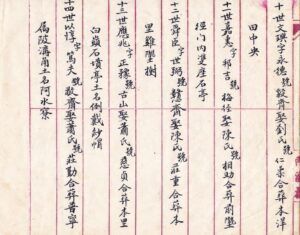Sources for Family Research
Chinese Surnames
The first step is finding your family's true surname. During the Chinese Exclusion Act period (1882-1943), many Chinese seeking to immigrate to the United States purchased fraudulent documentation papers from legal residents to enter the United States. The 1906 San Francisco earthquake which destroyed City Hall and the Hall of Records, resulted in many Chinese declaring they were born in the United States and had children in China. These identities were sold to circumvent the immigration laws resulting in the use of false surnames.
Many Chinese immigrants entered the United States as "paper sons" and "paper daughters" and assumed the identity of the persons from whom the "papers" were purchased. Descendants of these "paper" immigrants were left sorting through written documents to determine their family's true surname.
Immigration and census officials recorded names with little understanding of Chinese naming convention. The many variations of these names poses another challenge in identifying the real surname in official records. Many of the surnames in immigration files were written in Cantonese Romanization, and have romanization variations due to dialect differences.
The 100 most common Chinese surnames are listed in this database.
Chinese Family Associations and Cemeteries

District and family associations were organized to serve and assist Chinese immigrants and American-born Chinese. The associations provided a physical place to fraternize and offered aid and support. Some of these organizations may have access to jiapu or zupus, photographs, membership lists and also manage Chinese cemeteries. The family association may be able to help you identify and locate the name of your family village.
Chinese cemeteries in the United States are often managed by family associations. Contacting the association may reveal more information.
Information about deceased relatives may be discovered at gravesites. Real surnames of paper sons and daughters, village names and clan names of wives may be discovered as well as dates of birth and death. Also, the province, district and ancestral village of birthplace may be written in Chinese characters. The family village in Chinese may indicate the name of the clan(s) that resided in that village.
Family Genealogy Books, Jiapu 家谱 or Zupu 家譜

Chinese family history is recorded in a jiapu/zupu, or genealogy book. The jiapu (家谱) and zupu (族谱) are technically different, as jiapu means "family book" and zupu means "clan book". The books trace the male lineage from the first progenitor to the present. Wives and sometimes daughters were listed, but matriarchal lines were not usually traced. A jiapu can contain achievements, migration history, guidelines, moral codes, and generation poems. The village birthplace and burial site for each male relative may also be listed.
The zupu and jiapu are the holy grails in family genealogy research. Unfortunately, many family genealogy books dating from the 9th to 13th centuries were destroyed during the Cultural Revolution (1966-1976). Families may have handwritten or printed copies either in the ancestral village or brought with them to the United States.
Siyi Genealogy
The Siyi Genealogy site is devoted to the genealogy of Chinese families from the area of Guangdong, China commonly known as Siyi or four counties. The counties are Xinhui, Taishan, Kaiping, and Enping. This is an open forum board and is not restricted. All visitors are welcome to post, share their thoughts, experiences and observations.
For more detailed information about how to trace your Chinese family history, become a member to access our Digital Guide to Researching Family History
